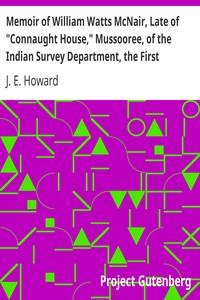|
|
Read this ebook for free! No credit card needed, absolutely nothing to pay.Words: 22991 in 4 pages
This is an ebook sharing website. You can read the uploaded ebooks for free here. No credit cards needed, nothing to pay. If you want to own a digital copy of the ebook, or want to read offline with your favorite ebook-reader, then you can choose to buy and download the ebook.

: Memoir of William Watts McNair Late of Connaught House Mussooree of the Indian Survey Department the First European Explorer of Kafiristan by Howard J E - McNair William Watts 1849-1889; Nuristani (Asian people); Nuristan (Afghanistan) Description and trav@FreeBooksTue 06 Jun, 2023 INSCRIBED TO THE ROYAL GEOGRAPHICAL SOCIETY OF LONDON, IN REMEMBRANCE OF A LIFE MADE HAPPIER BY ITS RECOGNITION OF RARE AND MODEST WORTH. MEMOIR. To those who know what an Indian Department means, such language of eulogy, no less truthful than graceful, from so respected a functionary as the Surveyor-General of India, who knew Mr. McNair personally, will carry a weight far beyond the official recognition of that deceased officer's worth to his department. The comparative neglect of a great scientific department of State, such as the Indian Survey Department undoubtedly is, as a mere ornamental section of the huge and complicated machinery of that gigantic Empire called India, is but too often repeated by a department and its official heads in regarding the merits of the living and the dead who sacrifice their lives to its achievements; but in this one instance, at least, it cannot be said that the head of a department fell beneath his opportunities for doing himself and his subordinate due honour. It is not always from official neglect, or human pride and indifference, that this want of sympathy for human labour and human devotion arises, but rather from the infinite preoccupations and monotonous overwork of the faculties of all public servants of any position of importance in that vast continent of swarming bees intent on their day's labour and nothing else. It is a good token for the future that men shall feel their labour is appreciated, although a desire for official recognition may be no incentive to the devotion itself. It is certain that William McNair always valued the appreciation of his official superiors, and that nothing could have given him greater pleasure or more comfort, in his review of his own brief labours, than to have known he would be thus remembered by the head of his own department. To natures that regard the daily associations of an arduous career as giving a sanctification all their own, the testimony of colleagues--and, most of all, of the responsible mouthpiece of those colleagues--is specially and naturally dear. Within this period of twenty-two years' faithful service to the State occurred the remarkable exploit, the account of which, as read in a paper before the Royal Geographical Society of London, on the 10th December, 1883, I transcribe into this memoir direct from the proceedings of that society, published in the number for January, 1884, in the following words, giving the substance of what was said by the President of the society, who introduced the lecturer, and the several speakers who raised a discussion on the subject of the paper after it had been read. PROCEEDINGS OF THE ROYAL GEOGRAPHICAL SOCIETY. In order to let the reader see how perfect was the disguise of McNair during his Kafiristan expedition, I have prefixed to this Memoir a portrait of McNair, taken a year or two before his death, and to the paper read before the Royal Geographical Society, the group attired as on their journey, with McNair in the centre, and his Mahommedan friends around him. In introducing Mr. McNair to the meeting, the President said that the paper he was about to read was an account of a visit he had recently made to Kafiristan. Mr. McNair had resided in India for a long time previous to his adventurous journey, and whilst in the service of the Topographical Department in the North-west of India, had been employed in surveys beyond the frontier of Afghanistan. His attention was thus directed to the interesting country which the paper would describe. Kafiristan was a country of very peculiar interest. The name Kafiristan, or the "country of infidels," was a nick-name given by the surrounding Mahommedans, and was not that by which it was called by the natives. It had long been a reproach to English geographers that the only accounts of Kafiristan had been obtained through Orientals themselves, whose statements had never been tested by the actual visit of Europeans to the country. The consequence was that a sort of mystery surrounded Kafiristan,--so much so that Colonel Yule, when discussing an interesting paper by Colonel Tanner, on a visit he made to the borders of the Kafir country three years ago, said that when Kafiristan was visited and explored the Royal Geographical Society might close the doors, because there would be no more new work to be done. The veil had at last been drawn aside. It might be asked why the country had been so long held inaccessible. The explanation was that the inhabitants were always at war with their Mahommedan neighbours, by whom they were surrounded on all sides, and who had been extremely jealous of their communication with European travellers. Mr. McNair had penetrated Kafiristan in disguise. He had had an opportunity of seeing the paper, and he found that Mr. McNair had not dwelt upon the historical geography of Kafiristan, and therefore he would say a few words on that subject. As long ago as 1809, Kafiristan attracted the attention of one of the ablest public servants that England ever sent out to India--Mountstuart Elphinstone--who was anxious to add to his "History of Kabul" something about the people of Kafiristan; and knowing that it was inaccessible to Europeans, he employed an Indian, a man of learning and intelligence, to travel there and obtain all the information he could. It was curious to notice how faithful the report of his emissary was. The people of the country were described in the following words: "The Kafirs were celebrated for their beauty and their European complexions. They worshipped idols, drank wine in silver cups or vases, used chairs and tables, and spoke a language unknown to their neighbours." Their religion seems to have been a sort of debased Deism: they believed in a God; at the same time they worshipped a great number of idols, which they said represented the great men that had passed from among them; and he described a scene at which he had been present, when a goat or a cow was sacrificed, and the following prayer, pithy and comprehensive, although not remarkable for charity, was offered up: "Ward off fever from us. Increase our stores. Kill the Mussulmans. After death admit us to Paradise." Killing the Mussulman was a religious duty which the Kafirs performed with the greatest fidelity and diligence. In fact, no young man was allowed to marry until he had killed a Mussulman. They attached the same importance to the killing of a Mussulman as the Red Indians did to taking the scalp of an enemy. Their number did not appear to exceed 250,000. They inhabited three valleys, and small as their number was they were constantly at war with each other, and seized upon the members of kindred tribes in order to sell them as slaves. The women were remarkable for their beauty; and Sir Henry Rawlinson once said at one of their meetings that the most beautiful Oriental woman he ever saw was a Kafir, and that she had, besides other charms, a great mass of golden hair, which, let loose and shaken, covered her completely from head to foot like a veil. In order to show what was the state of our knowledge of the country down to 1879, he would read part of a paper by Mr. Markham on "The Upper Basin of the Kabul River." "This unknown portion of the southern watershed of the Hindu Kush is inhabited by an indomitable race of unconquered hill-men, called by their Muslim neighbours the Siah-posh Kafirs. Their country consists of the long valleys extending from the Hindu Kush to the Kunar river, with many secluded glens descending to them, and intervening hills affording pasturage for their sheep and cattle. The peaks in Kafiristan reach to heights of from 11,000 to 16,000 feet. The valleys yield crops of wheat and barley, and the Emperor Baber mentions the strong and heady wine made by the Kafirs, which he got when he extended his dominion to Chigar-serai in 1514. The Kafirs are described as strong athletic men with a language of their own, the features and complexions of Europeans, and fond of dancing, hunting, and drinking. They also play at leap-frog, shake hands as Englishmen, and cannot sit cross-legged on the ground. When a deputation of Kafirs came to Sir William Macnaghten at Jalalabad, the Afghans exclaimed: 'Here are your relations coming!' From the days of Alexander the Great the Siah-posh Kafirs have never been conquered, and they have never embraced Islam. They successfully resisted the attacks of Mahmud of Ghazni, and the campaign which Timur undertook against them in 1398 was equally unsuccessful. But the Muslim rulers of Kabul continued to make inroads into the Siah-posh country down to the time of Baber and afterwards. Our only knowledge of this interesting people is from the reports of Mahommedans, and from an account of two native missionaries who penetrated into Kafiristan in 1865. Elphinstone obtained much information respecting the Kafirs from one Mullah Najib in 1809; and Lumsden from a Kafir slave named Feramory, who was a general in the Afghan service in 1857. Further particulars will be found in the writings of Burnes, Wood, Masson, Raverty, Griffith, and Mohun Lal." In recent years, Major Biddulph entered from Kashmir, through Gilgit, and made his way to Chitral, and Colonel Tanner advanced from Jalalabad a short distance into Kafiristan, among a portion of the people who had been converted to Mahommedanism, but who still retained many of the peculiarities of the Kafir race. Dr. Leitner had also taken great pains to obtain information about this ancient and unconquered people but Mr. McNair was the first European who had ever penetrated into Kafiristan. Mr. McNair then read as follows:-- In the September number of this Society's "Proceedings," p. 553, under the heading "An Expedition to Chitral," allusion is made to my being accompanied by a native explorer known "in the profession" as the Saiad; it is to this gentleman that I am indebted for the partial success that attended our undertaking. I say partial advisedly, inasmuch as the original programme we had marked out, of penetrating into the heart of Kafiristan, fell through, for reasons that will appear as I proceed with the narrative. It may not be out of place if I here mention that the Kaka Khel section of Pathans, to which the two Meahs belong, are not only very influential, but are respected throughout both Afghanistan and Badakshan. The Kafirs also pay them a certain amount of respect, and will not knowingly attack them, owing to an epidemic of cholera which once broke out amongst them immediately after they had returned from murdering a party of Kaka Khels, and which they superstitiously attributed to their influence. They number in all a few short of 3,500; this includes menials and followers. Though really considered spiritual advisers they are virtually traders, and I do not think I am far wrong in saying that they have the monopoly of the trade from Kabul eastward to the borders of Kashmir territory. If you say that you are a Meahgan or Kaka Khel, words signifying one and the same thing, you have not only access where others are questioned, and a sort of blackmail levied on them, but you are treated hospitably, and your daily wants supplied free of cost--as was often the case with us. Of course the Meaghans have to make some return. It is done in this wise: a fair lasting from five to seven days is yearly held at Ziarat, a village five miles south-west of Nowshera, the resting-place of the saint Kaha Sahib; it is resorted to by thousands from across our north and east frontiers, and all comers are housed and fed by the Meahs collectively. Offerings, it is true, are made to the shrine, but I am told the amount collected is utilised solely for the keeping up of the shrine. The Malakand Pass is well wooded with brushwood and stunted oak; grass and a goodly supply of water from springs are procurable all through the year. The ascent is easy, and practicable for heavy baggage. The descent into the Swat Valley is not nearly so easy; beasts of burden as well as foot passengers have to pick out their way, but a company of Bengal or Madras sappers would in a few hours clear all difficulties sufficiently well to allow a mule battery to keep up with infantry. When once in the plains this state of things changes; where previously one had to avoid loose rocks and boulders, we had now to search for a dry spot on which to alight. Both banks of the rivers are irrigated; the soil is very rich, and well adapted for rice cultivation. The valley has the reputation of being very unhealthy, owing, I have no doubt, to the effluvia arising from the damp soil. A Swatie is easily recognised by the sallow appearance he presents--a striking contrast to his nearest neighbours. The descent from the pass, which registered 7,310 feet, to Killa Rabat in the Panjkhora Valley, was for the first half of the distance by a long and densely wooded spur, within an easy slope, but on nearing the foot we found it very stony. Our party was met at the entrance by the khan, and later on we were invited to dinner by him. Long before this I had got quite used to eating with my fingers, but on this occasion I must admit I found it unpleasant diving the fingers into a richly made curry floating in grease, and having at the next mouthful to partake of honey and omelet. The banquet lasted for an hour or more, and I was beginning to feel uncomfortable sitting on the ground in the one position so peculiar to Eastern nations, when the hookah came to my rescue, and allowed of a change in position. We forded the Panjkhora a little above the fort, and by 5 p.m. reached Shahzadgai. Free books android app tbrJar TBR JAR Read Free books online gutenberg More posts by @FreeBooks
: Bible Stories and Religious Classics by Wells Philip P Philip Patterson - Christian literature for children; Bible stories English Juvenile literature Children's Religion@FreeBooksTue 06 Jun, 2023
|
Terms of Use Stock Market News! © gutenberg.org.in2025 All Rights reserved.






